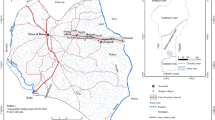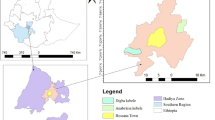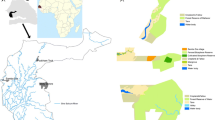Abstract
Agroforestry systems are potentially suitable for conservation of tree genetic resources. Farmers around Mt. Kenya usually integrate trees into their farm. Large parts of these trees seem to be of exotic origin, whereas indigenous species have priority for conservation. This study aimed at determining on-farm richness, composition and frequency of indigenous and exotic woody species around Mount Kenya to assess the suitability of farms for the conservation of indigenous tree species. 265 on-farm plots of 0.5 ha size each were selected in 18 different agro-ecological zones by using a stratified sampling scheme. All woody species within the plot were recorded with their local and scientific names. Total species richness was 424 (including 306 indigenous ones), mean richness per plot 16.5 species (including 8.8 indigenous ones). Eight out of the 10 most frequent species were exotic ones with Grevillea robusta from Australia ranking first (found on almost 76% of the surveyed farms). The proportion of indigenous species increased with increasing aridity and temperature. Dominance of exotic species was found at farms of humid mid- and highlands. Ordination analysis revealed that mostly exotic species contributed to separation of farms in the highlands and upper midlands, whereas indigenous species in the lower midlands and lowlands. As the frequencies of most indigenous trees were low, only parts of the surveyed farms can contribute to conservation of tree genetic resources, particularly the less intensively managed farms of the more arid lands. Farmers’ access to knowledge on valuable indigenous tree species and to quality seedlings of these trees need to be improved to increase indigenous species’ frequencies on farms and possibly to replace some of the exotic species in the future.






Similar content being viewed by others
References
Acharya KP (2006) Linking trees on farms with biodiversity conservation in subsistence farming systems in Nepal. Biodivers Conserv 15:631–646
Atta-Krah K, Kindt R, Skilton JN, Amaral W (2004) Managing biological and genetic diversity in tropical agroforestry. Agrofor Syst 61:183–194
Beentje HJ (1994) Kenya trees, shrubs and lianas. National Museum of Kenya, Nairobi, Kenya
Bhagwat SA, Willis KJ, Birks JB, Whittaker RJ (2008) Agroforestry: a refuge for tropical biodiversity? Trends Ecol Evol 23:261–267
Bussmann RW (1996) Destruction and management of Mount Kenya’s forests. Ambio 25:314–317
Carpenter C (2005) The environmental control of plant species density on a Himalayan elevation gradient. J Biogeogr 32:999–1018
CITES (Convention on international trade in endangered species of wild fauna and flora) (2010) Appendices I, II and III, valid from 14 October 2010. http://www.cites.org/eng/app/Appendices-E.pdf. Accessed 29 Dec 2010
Correia M, Diabaté M, Beavogui P, Guilavogui K, Lamanda N, de Foresta H (2010) Conserving forest tree diversity in Guinée Forestière (Guinea, West Africa): the role of coffee-based agroforests. Biodivers Conserv 19:1725–1747
Dawson IK, Lengkeek A, Weber JC, Jamnadass R (2009) Managing genetic variation in tropical trees: linking knowledge with action in agroforestry ecosystems for improved conservation and enhanced livelihoods. Biodivers Conserv 18:969–986
Dawson IK, Vinceti B, Weber JC, Neufeldt H, Russell J, Lengkeek AG, Kalinganire A, Kindt R, Lillesø JPB, Roshetko J, Jamnadass R (2011) Climate change and tree genetic resource management: maintaining and enhancing the productivity and value of smallholder tropical agroforestry landscapes. A review. Agrofor Syst 81:67–78
Day RK, Kairo MTK, Abraham YJ, Kfir R, Murphy ST, Mutitu KE, Chilima CZ (2003) Biological control of Homopteran pests of conifers in Africa. In: Neuenschwander P, Borgemeister C, Langewald J (eds) Biological control in IPM systems in Africa. CAB International, Wallingford, UK, pp 101–112
FAO (2010) Global forest resources assessment 2010. Main report. FAO forestry paper 163. http://www.fao.org/docrep/013/i1757e/i1757e.pdf. Accessed 17 Dec 2010
Garrity DP (2004) Agroforestry and the achievement of the millennium development goals. Agrofor Syst 61:5–17
Gathaara GN (1999) Aerial survey of the destruction of Mt. Kenya, Imenti and Ngarendare forest reserves. February–June 1999. Forest Conservation Programme, Kenya Wildlife Service, Nairobi, Kenya. http://www.kenyaforests.org/index.php?option=com_remository&Itemid=79&func=fileinfo&id=9. Accessed 06 May 2009
Gibbons P, Lindenmayer DB, Fischer J, Manning AD, Weinberg A, Seddon J, Ryan P, Barrett G (2008) The future of scattered trees in agricultural landscapes. Conserv Biol 22:1309–1319
Hector A, Bagchi R (2007) Biodiversity and ecosystem multifunctionality. Nature 448:188–191
Hemp A (2006) The banana forests of Kilimanjaro: biodiversity and conservation of the Chagga homegardens. Biodivers Conserv 15:1193–1217
Jaetzold R (1983) Atlas of agro-ecological zones of Kenya. Supplement to the farm management handbook of Kenya. Ministry of Agriculture, Nairobi, Kenya
Jaetzold R, Schmidt H (1983) Farm management handbook of Kenya, vol II B and C. Ministry of Agriculture, Nairobi, Kenya
Jamnadass R, Lowe A, Dawson IK (2009) Molecular markers and the management of tropical trees: the case of indigenous fruits. Trop Plant Biol 2:1–12
Kalinganire A, Hall JB (1993) Growth and biomass production of young Grevillea robusta provenances in Rwanda. For Ecol Manag 62:73–84
Kehlenbeck K, Arifin HS, Maass BL (2007) Plant diversity in homegardens in a socio-economic and agro-ecological context. In: Tscharntke T, Leuschner C, Zeller M, Guhardja E, Bidin A (eds) The stability of tropical rainforest margins: linking ecological, economic and social constraints of land use and conservation. Springer, Berlin, Germany, pp 297–319
Kindt R, Coe R (2005) Tree diversity analysis. A manual and software for some common statistical methods for biodiversity and ecological analysis. World Agroforestry Centre (ICRAF), Nairobi, Kenya. http://www.worldagroforestry.org/treesandmarkets/tree_diversity_analysis.asp. Accessed 06 January 2009
Kindt R, Lillesø JPB, van Breugel P (2007) Comparisons between original and current composition of indigenous tree species around Mount Kenya. Afr J Ecol 45:633–644
Legendre P, Anderson MJ (1999) Distance-based redundancy analysis: testing multi-species responses in multi-factorial ecological experiments. Ecol Monogr 69:1–24
Legendre P, Legendre L (1998) Numerical ecology. Elsevier Science, Amsterdam, The Netherlands
Lengkeek AG, Kindt R, van der Maesen LJG, Simons AJ, van Oijen DCC (2005) Tree density and germplasm source in agroforestry ecosystems in Meru, Mount Kenya. Genet Resour Crop Evol 52:709–721
Msuya TS, Mndolwa MA, Kapinga C (2008) Domestication: an indigenous method in conserving plant diversity on farmlands in west Usambara Mountains, Tanzania. Afr J Ecol 46:74–78
Munishi PKT, Philipina F, Temu RPC, Pima NE (2008) Tree species composition and local use in agricultural landscapes of west Usambaras Tanzania. Afr J Ecol 46:66–73
Oksanen J, Kindt R, Legendre P, O’Hara RB (2008) Vegan: community ecology package version 1.7–82. http://cc.oulu.fi/jarioksa/. Accessed 06 Jan 2009
Olukoye GA, Wamicha WN, Kinyamario JI (2003) Assessment of the performance of exotic and indigenous tree and shrub species for rehabilitating saline soils of Northern Kenya. Afr J Ecol 41:164–170
R Development Core Team (2008) R: a language and environment for statistical computing. R foundation for statistical computing, Vienna, Austria. http://www.R-project.org. Accessed 06 Jan 2009
Schroth G, da Fonseca GAB, Harvey CA, Gascon C, Vasconcelos H, Izac AN (2004) Agroforestry and biodiversity conservation in tropical landscapes. Island Press, Washington, USA
Takaoka S (2008) A comparison of the utility and agronomic traits of indigenous and exotic trees in the Mount Kenya region. Small Scale For 7:77–85
Wiersum KF (2004) Forest gardens as an ‘intermediate’ land-use system in the nature-culture continuum: Characteristics and future potential. Agrofor Syst 61:123–134
Acknowledgments
We are grateful to all the farmers and their families that participated, shared their knowledge and helped us in the vegetation survey around Mt. Kenya. We highly appreciate Zenroku Oginosako (formerly ICRAF) for allowing us to use part of the results of the survey he and his team conducted around Mt. Kenya. Simon Mathenge (formerly at East Africa Herbarium) contributed to the identification of tree species and Meshack Nyabenge (ICRAF) to mapping. We would also like to acknowledge our colleagues at ICRAF for their suggestions, technical support and valuable comments. The initial stage of this survey was funded by the Toyota Foundation, later stages by the Ministry of Foreign Affairs of Japan.
Author information
Authors and Affiliations
Corresponding author
Rights and permissions
About this article
Cite this article
Kehlenbeck, K., Kindt, R., Sinclair, F.L. et al. Exotic tree species displace indigenous ones on farms at intermediate altitudes around Mount Kenya. Agroforest Syst 83, 133–147 (2011). https://doi.org/10.1007/s10457-011-9413-4
Received:
Accepted:
Published:
Issue Date:
DOI: https://doi.org/10.1007/s10457-011-9413-4




